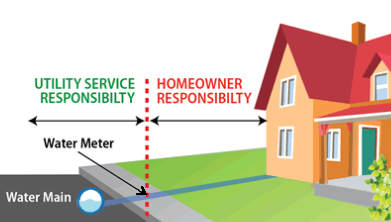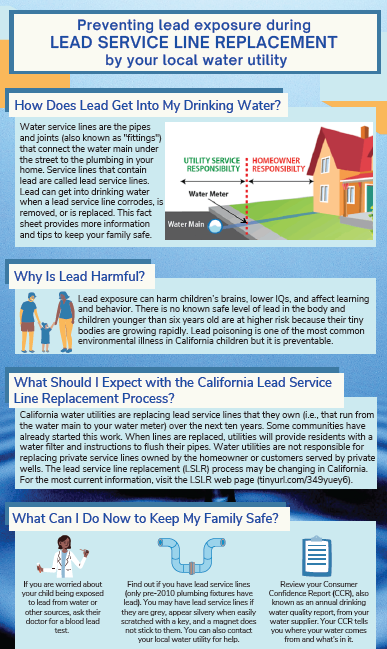Lead Service Line Replacement
Water service lines are the pipes and joints (also known as "fittings") that connect the plumbing in your home to the water main under the street. Service lines that contain lead are called lead service lines. California public water utilities are replacing lead service lines that they own (i.e., the section that runs from the water main to your water meter) over the next ten years. Water utilities are not responsible for replacing private service lines owned by the homeowner or customers served by private wells. Check if your local water utility has a lead service line replacement (LSLR) timeline, and where and when it will happen on the California Waterboards' LSLR Status Map Update (Excel spreadsheet). The lead service line replacement process may be changing in California. This web page will be updated as changes occur.

Why is this important?
Lead is a toxic metal that has been used in many products over time. Lead can get into drinking water when a lead service line corrodes, is removed, or is replaced. Lead exposure can harm children's brains, lower IQs, and affect learning and behavior. Children younger than six years old are at higher risk because their bodies are growing rapidly.
How can I learn if my service line or tap water has lead?
- Contact your local water utility to learn if you have a lead service line or for recommendations on testing if it is made from lead.
- Review your Consumer Confidence Report (CCR), also known as an annual drinking water quality report, from your water supplier. Your CCR tells you where your water comes from and what's in it.
- Inspect your home's pipes and fittings (PDF) (only pre-2010 plumbing fixtures have lead). You may have lead service lines if they are grey, appear silvery when easily scratched with a key, and a magnet does not stick to them. You can also contact your local water utility for help.
- Note on galvanized pipes: Houses built during the 1960s and earlier often have galvanized water pipes. The process to make galvanized pipes can include small amounts of lead. When galvanized pipes get old and rusty, the lead can get into the drinking water. Galvanized pipes are a dull, silver-grey color. Strong magnets will usually cling to galvanized pipes.
What can I do now to keep my family safe?
- If you are worried about your child being exposed to lead from water or other sources, ask their doctor for a blood lead test.
- Flush pipes that have not been used for more than 6 hours until the water feels very cold. To save water, collect the running water and use it to water plants not intended for eating.
- Use only cold water for drinking, cooking, and baby formula. If water needs to be heated, use cold tap water and heat on the stove or in a microwave. Hot tap water is more likely to have lead in it. Boiling water does not remove lead.
- Consider using a water filter registered to treat lead. Learn how to identify filters certified to reduce lead (PDF) by the certification marks on the packaging. When lead service lines are replaced, utilities will provide residents with a water filter and instructions to flush their pipes.
- Periodically clean your water faucet's aerator (screen) to remove contaminants.
Where can I get more information?
- State Water Resources Control Board, Division of Drinking Water: Lead Service Line Inventory: This web page provides an overview of LSLR and includes multiple resources and links for more information, including the following:
- Interactive map highlights which communities have lead service lines.
- Frequently Asked Questions: Lead Service Lines and the New Interactive Map (PDF) from the California Waterboards
- Lead Service Line Replacement Collaborative: This website is intended to be a resource for community leaders, elected officials, drinking water professionals, and public health professionals, but also includes information for individual consumers.
- Environmental Protection Agency: Protect Your Tap: A Quick Check for Lead: This guide will help you determine if you have a lead service line bringing water into your home. It uses pictures, step-by-step directions to identify lead service lines, provides tips to reduce lead exposure, information on testing your water, and resources to learn more.
- EPA Infographic: Lead in Drinking Water: This infographic provides basic information about sources of lead in drinking water, suggestions for reducing exposure, and information about replacing lead service lines. The web page includes links to the infographics in English and Spanish.
- General information on lead poisoning: Childhood Lead Poisoning Prevention Branch web page with family resources and guidance for preventing lead exposure.
 View/download the infographic - Bilingual (English/Spanish) (PDF) with information about LSLR and tips for keeping your family lead-safe.
View/download the infographic - Bilingual (English/Spanish) (PDF) with information about LSLR and tips for keeping your family lead-safe.